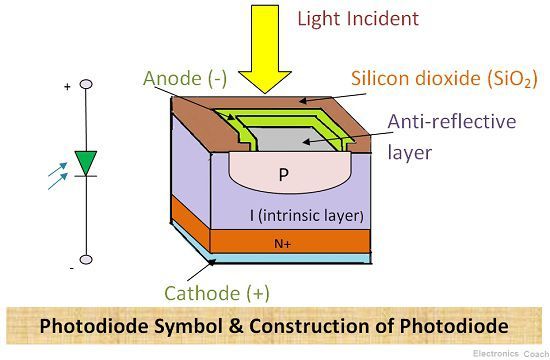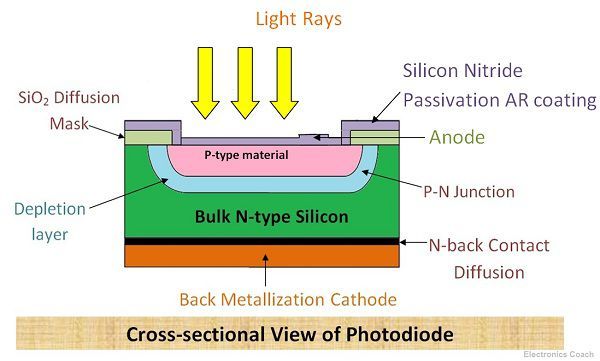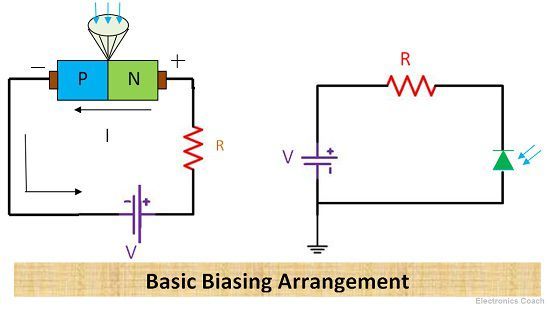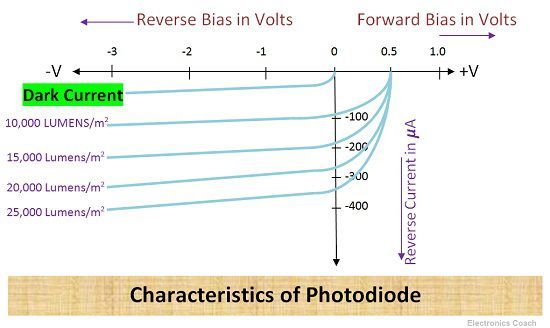Definition: Photodiode is a two terminal electronic device which, when exposed to light the current starts flowing in the diode. It is operated in reverse biased mode only. It converts light energy into electrical energy. When the ordinary diode is reverse biased the reverse current starts increasing with reverse voltage the same can be applied to the photodiode.
But in the case of photodiode the current can flow without application of reverse voltage, the P-N junction of the photodiode is illuminated by light and light energy dislodge valence electrons and the diode starts conducting.
Construction of Photodiode
The photodiode is made up of two layers of P-type and N-type semiconductor. In this, the P-type material is formed from diffusion of the lightly doped P-type substrate. Thus, the layer of P+ ions is formed due to the diffusion process. And N-type epitaxial layer is grown on N-type substrate. The P+ diffusion layer is developed on N-type heavily doped epitaxial layer. The contacts are made up of metals to form two terminal cathode and anode.

The front area of the diode is divided into two types that are active surface and non-active surface. The non-active surface is made up of SiO2 (Silicon di Oxide) and the active surface is coated with anti-reflection material. The active surface is called so because the light rays are incident on it.
While on the non-active surface the light rays do not strike. The active layer is coated with anti-reflection material so that the light energy is not lost and the maximum of it can be converted into current. The entire unit has dimensions of the order of 2.5 mm.
Working Principle of Photodiode
When the conventional diode is reverse biased, the depletion region starts expanding and the current starts flowing due to minority charge carriers. With the increase of reverse voltage, the reverse current also starts increasing. The same condition can be obtained in Photodiode without applying reverse voltage.

The junction of Photodiode is illuminated by the light source, the photons strike the junction surface. The photons impart their enrgy in the form of light to the junction. Due to which electrons from valence band get the energy to jump into the conduction band and contribute to current. In this way, the photodiode converts light energy into electrical energy.

The current which flows in photodiode before light rays are incident on it is called dark current. As leakage current flows in the conventional diode, similarly the dark current flows in the photodiode.
Modes of Operation of Photodiode
It operates in two modes that are Photo-conductive and Photo-voltaic.
- Photo-Conductive: When the Photo diode operates in reverse biased mode it is called Photoconductive mode. In this, the current flowing in diode varies linearly with the intensity of light incident on it. In order to turn-off the diode, it should be provided with forward voltage.
- Photo-Voltaic: When the diode is operated without reverse biased it is said to be operated in photovoltaic mode. When the reverse biased is removed, the charge carriers are swept across the junction. The barrier potential is negative on N-side and positive on P-side.
When an external circuit is connected to photodiode after removal of reverse biasing, the minority carriers in both P, as well as N-region, return to their original region. It means the electrons which crossed the junction from N-type to P-type again move to N-side with the help of external circuit.
And the holes which crossed the junction and moved from P-type to N-type during junction fabrication will now again move to P-side with the help of external circuit.
Thus, the electrons can now flow out from N-type and holes can flow out from P-type thus in this condition they behave as voltage cell having N-type as the negative terminal and P-type as a positive terminal. Thus, the photodiode can be used as a photoconductive device or a photovoltaic device.
V-I Characteristics of Photodiode
The characteristics curve of the photodiode can be understood with the help of the below diagram. The characteristics are shown in the negative region because the photodiode can be operated in reverse biased mode only.

The reverse saturation current in the photodiode is denoted by I0. It varies linearly with the intensity of photons striking the diode surface. The current under large reverse bias is the summation of reverse saturation current and short circuit current.
I = Isc + I0 (1 – eV/ɳVt)
Where Isc is the short circuit current, V is positive for forward voltage and negative for reverse bias, Vt is volt equivalent for temperature, ɳ is unity for germanium and 2 for silicon.
Advantages of Photodiodes
- The reverse current is low in the tens of microamperes.
- The rise and fall times in case of photodiodes is very small making it suitable for high-speed counting and switching applications.
Disadvantages of Photodiodes
Photodiodes have lower light sensitivity than cadmium sulphide LDRs (Light dependent resistors), thus they CdS LDRs are considered more suitable for some applications.
Applications of Photodiodes
- It is used for detection of both visible as well as invisible light rays.
- Photodiodes are used for the communication system for encoding & demodulation purpose.
- It is also used for digital and logic circuits which require fast switching and high-speed operation.
- These diodes also find application in character recognition techniques and IR remote control circuits.
Photodiodes are considered as one of the significant optoelectronics devices which is extensively used in the optical fibre communication system.
Leave a Reply